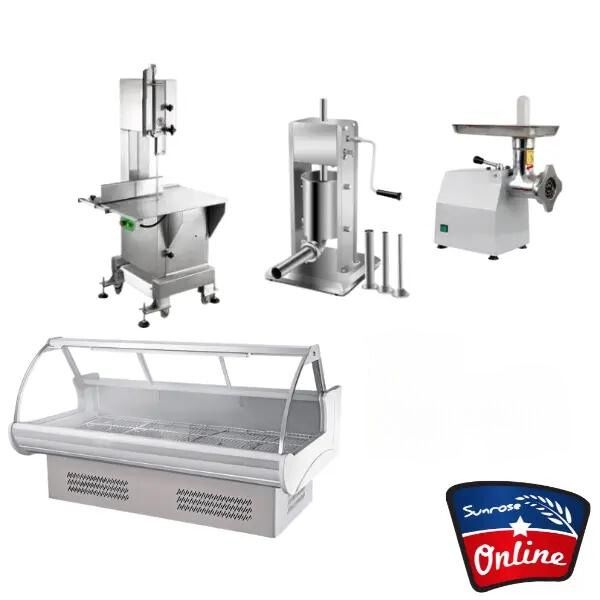12 Must-Have Tools Found in Every Butchery Equipment Set
The Ultimate Guide to Preserving Your Butchery Equipment for Durability
Preserving butchery equipment is necessary for making sure safety and security and effectiveness in meat processing. Regular upkeep not only enhances performance however also minimizes the danger of accidents. From day-to-day cleansing routines to professional maintenance, every facet plays a crucial duty in devices durability. Understanding these practices can significantly affect the operational success of a butchery. What actions should one prioritize to attain excellent efficiency and safety?
Understanding the Relevance of Tools Upkeep
Although frequently forgotten, the maintenance of butchery equipment is crucial for ensuring both safety and performance in the meat processing market. Routine examinations and servicing of blades, saws, and grinders are critical to stop crashes and assure peak efficiency. Dull blades can cause higher force being used, raising the risk of slides and injuries. Additionally, well-kept equipment runs more efficiently, reducing waste and improving productivity.Neglecting upkeep can lead to pricey repairs or substitutes, which impact a business's profits. By adhering to a scheduled maintenance strategy, butchers can prolong the life-span of their devices and equipment. This positive approach not only guarantees conformity with health and safety laws but additionally cultivates a workplace concentrated on quality and precision. Ultimately, understanding the relevance of devices maintenance is necessary for any butchery intending to grow in an affordable market while focusing on the well-being of staff members and customers alike.
Daily Cleansing and Sanitization Practices
Keeping a tidy and sanitized office is crucial for butchers, as it straight influences food security and top quality. Daily cleaning practices must begin with the elimination of any food debris and deposits from all surfaces, consisting of cutting boards, countertops, and tools. Butchers must utilize ideal cleaner that properly remove bacteria while being risk-free for food-contact surfaces.After cleansing, detailed sanitization is basic. This entails using a food-safe sanitizer to all surfaces, permitting adequate contact time to ensure effectiveness. Butchers have to likewise take notice of tools, tools, and devices, making particular they are cleaned, rinsed, and sanitized after each use.In enhancement, correct handwashing methods ought to be followed, as hand hygiene is significant in protecting against cross-contamination. By executing these daily cleansing and sanitization methods, butchers can keep a risk-free and efficient work atmosphere, ultimately boosting the general high quality of their products.
Sharpening and Refining Your Knives
Sharpening and developing blades is a vital skill for butchers, as sharp tools improve effectiveness and precision in reducing. Regular upkeep of blades not just improves performance yet likewise ensures security throughout cooking. Butchers need to comprehend the distinction in between honing and developing; honing removes product to bring back the blade's side, while honing straightens the edge for optimal cutting.To develop knives, making use of a whetstone or professional honing solution is suggested. It is important to preserve the right angle throughout sharpening to achieve a constant side. Honing can be made with a refining steel, which ought to be utilized frequently to keep knives in prime condition.Butchers ought to likewise be mindful of the material of their blades, as various types require certain treatment methods. A properly maintained blade will bring about much less fatigue and better outcomes, making developing and refining an important part of butchery devices treatment.
Inspecting and Maintaining Saws and Grinders
Regular examination and maintenance of saws and grinders is essential for assuring peak efficiency and long life of butchery devices. Operators should consistently examine saw blades for wear and damages, trying to find nicks or monotony that could impact reducing efficiency. Cleansing the blades after each use aids stop build-up and corrosion, boosting their lifespan.Grinders likewise need interest; operators need to evaluate grinding plates and blades for indications of wear or imbalance. Routinely lubing relocating parts guarantees smooth operation and reduces possible breakdowns. It is essential to tighten all screws and screws to avoid vibrations that can bring about mechanical failure.Additionally, checking electric connections and cables for tearing or damages is crucial for safety and security. By sticking to an aggressive maintenance schedule, butchers can reduce downtime and expand the life of their saws and grinders, inevitably supporting a more effective and productive workplace.
Proper Storage Strategies for Butchery Tools
Correct storage strategies for butchery tools are vital for preserving their functionality and safety and security after upkeep jobs have actually been finished. Proper company lowers the risk of damage and guarantees that tools are conveniently available when needed. It is recommended to save knives in safety sheaths or magnetic strips to stop dulling and accidents. Cutting boards ought to be cleaned and kept upright to permit air blood circulation, protecting against wetness buildup.Saws and grinders need to be maintained in assigned storage areas, ideally in a dry, temperature-controlled environment to avoid deterioration. Tool shelfs can supply simple gain access to while maintaining tools off surfaces, reducing mess. In addition, regular checks on saved tools for indications of wear or damages will certainly aid keep their problem. By carrying out these storage techniques, butchers can extend the life of their tools and ensure a risk-free working atmosphere.
Scheduling Routine Specialist Servicing
Setting up regular expert maintenance is necessary for preserving the performance and long life of butchery devices. Professionals suggest that maintenance be conducted a minimum of annually, though even more constant checks may be essential based on usage degrees. This positive technique helps prevent costly failures and warranties conformity with wellness and safety and security requirements.
Importance of Specialist Upkeep
While the long life and performance of butchery tools are vital for functional success, lots of businesses overlook the necessity of important link expert maintenance. Normal expert maintenance plays a vital duty in guaranteeing that equipment runs at peak performance. Professionals possess specialized knowledge and skills, enabling them to identify issues that might not show up throughout routine checks. This proactive strategy not only prevents unanticipated breakdowns yet additionally extends the life expectancy of costly machinery. In addition, professional upkeep assists keep conformity with health and wellness policies, safeguarding both workers and clients. By buying specialist servicing, butchers can improve productivity, reduce fixing costs, and promote a much safer working useful content atmosphere, ultimately adding to the general success and online reputation of their company.
Advised Maintenance Regularity
Establishing a regular maintenance timetable for butchery equipment is crucial for keeping peak performance and reliability. Commonly, butchers need to go for specialist maintenance every 6 to twelve months, depending on devices usage and workload. High-volume procedures might require more frequent checks, while smaller facilities can comply with the longer interval.Regular maintenance helps identify possible issues before they intensify, ensuring security and functional effectiveness. It is recommended to seek advice from maker standards for details recommendations concerning each item of equipment. Furthermore, keeping in-depth documents of servicing days and performed jobs can aid in monitoring devices health and wellness and intending future maintenance. By adhering to an advised maintenance frequency, butchers can significantly enhance the long life and performance of their devices.
Identifying Signs of Deterioration
Identifying indicators of deterioration in butchery devices is essential for maintaining peak performance. By utilizing visual evaluation techniques, drivers can identify prospective problems before they escalate. Furthermore, noting any kind of efficiency abnormalities can educate required modifications to the normal upkeep routine.
Visual Assessment Techniques
Visual inspection functions as a necessary very first line of protection in recognizing damage on butchery equipment. Frequently taking a look at tools and machinery permits operators to detect potential issues prior to they escalate. Key locations to concentrate on include blades, joints, and surfaces for indications of rust, monotony, or splits. web Evaluating manages and grips warranties they are safe and devoid of damages, which can endanger security. Furthermore, checking out electrical components for tearing cords or loose connections is important. An extensive aesthetic inspection needs to be conducted regularly, preferably after each usage, to keep peak performance and expand the life of the devices. By being attentive, butchers can assure their tools stay in prime problem and secure their operational effectiveness.
Efficiency Anomalies
A number of subtle performance anomalies can indicate deterioration on butchery equipment, which may compromise efficiency and security. A visible reduction in reducing sharpness can indicate that blades are dull and require interest. Equipment may additionally display uncommon vibrations or sounds, suggesting imbalance or inner damages that might impact efficiency. In addition, irregular meat appearance or unequal cuts might indicate that machinery is not operating at its finest. Enhanced functional temperatures can indicate overheating electric motors or rubbing between components, taking the chance of prospective failure. Frequently monitoring these indicators is crucial, as they can lead to more substantial concerns if left unaddressed. Prompt recognition of these anomalies is necessary for preserving functionality and making certain a risk-free functioning setting in butchery operations
Normal Upkeep Arrange
Establishing a regular upkeep schedule is important for identifying indicators of damage on butchery devices, as positive treatment can avoid pricey fixings and assure peak performance. Regular inspections must be carried out to inspect for problems such as dull blades, loosened installations, or uncommon sounds. Scheduling upkeep tasks, such as developing knives or lubricating relocating parts, warranties that equipment stays in prime problem. Maintaining a maintenance log can assist track the frequency of solution and the particular jobs performed. Additionally, being mindful to equipment efficiency throughout daily procedures can inform operators to possible issues prior to they rise. By focusing on an organized maintenance routine, butchers can extend the life-span of their equipment and maintain efficiency in their procedures.
Regularly Asked Questions
Just how Commonly Should I Change My Butchery Devices?
The regularity of changing butchery devices differs based upon use and maintenance. Typically, knives might require substitute yearly, while bigger equipments can last numerous years, requiring routine assessments to determine when substitute is important for peak performance.
Can I Make Use Of Household Cleaners on My Butchery Equipment?

What Are the Ideal Products for Butcher Knives?
The very best materials for butcher blades normally consist of high-carbon stainless-steel for longevity, side retention, and corrosion resistance. Other options include ceramic for light-weight use and Damascus steel for aesthetic appeal and strength.
Is It Essential to Oil My Meat Saw?

Exactly How Can I Prevent Corrosion on My Equipment?
To stop rust on devices, regular cleaning is important. Applying a thin layer of oil after use produces a safety obstacle (Butchery Equipment). In addition, keeping devices in a completely dry environment helps decrease wetness exposure and reduces rust development